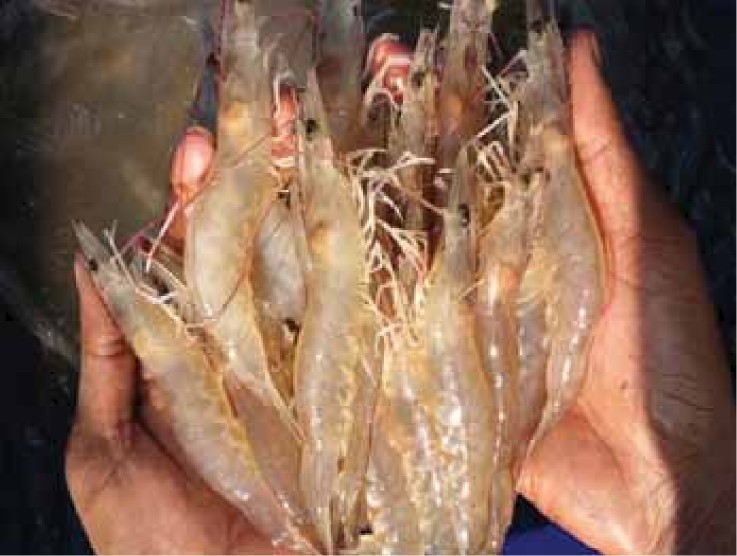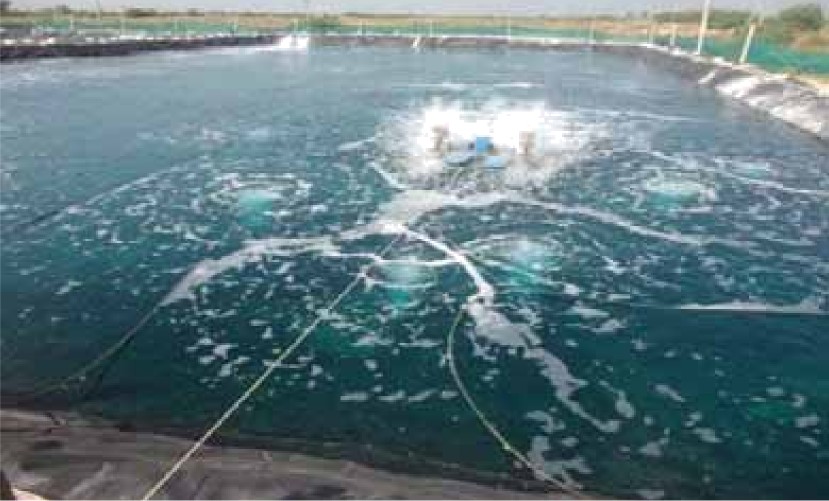Production of Vannamei Shrimp
Production of Vannamei Shrimp
The vannamei shrimp, Penaeus vannamei commonly known as white legged shrimp/ Pacific white shrimp/ Mexican white shrimp is the native of Pacific coast of Mexico and Central and South America. It is greyish- white in colour. The maximum weight of female in the wild is 120 g and that of male is 80 g. It is an omnivorous scavenger and less aggressive and less carnivorous than the tiger shrimp. It prefers clayey loam soil which can also remain in the water column during culture.
Penaeus vannamei

In India, its large-scale introduction was permitted in 2009 with specific guidelines for the import of broodstock, seed production and culture in a highly bio-secured environment. In order to eliminate the presence of virus in the seed, Specific Pathogen Free (SPF) brood stock has been developed by keeping a number of generations in highly bio- secured facility with continuous surveillance. Offspring of SPF shrimp is not considered as SPF unless it is produced and maintained at an SPF facility.
Seed Production
Procurement of broodstock
Specific pathogen free or specific pathogen resistant broodstock of 30-40 g size is procured, quarantined and kept in hatchery under strict bio-security measures.
Water quality management
The method is similar to that explained for the milkfish. Water is allowed to drain-off from the facility only after proper effluent treatment.
Maturation
The male and female broodstock are held separately in grey-coloured and smooth-sided maturation tank of 20-30 t capacity having clean filtered seawater up to a level of 50-70 cm with continuous mild aeration and re-circulation or with a daily water exchange of 250-300%. It is fed with fresh or frozen feed (krill, worms, squid, oyster, polychaete etc.) at 20-30% of the body weight or a dry feed having 45% protein @ 4-6% of the bodyweight. The maturation tank is maintained under dark condition. Other aspects of maturation practices and process of eyestalk ablation are similar to that of tiger shrimp.
Mating
For mating, gravid female is released into a mating tank of 20 t capacity with male in the ratio of 1:1 and density of 6-8 no./m2 for 4-5 hours. Water temperature is maintained at 27-28°C with a salinity of 30- 35 ppt and pH of 8.0-8.2.
Spawning
It is similar to that explained for the tiger shrimp. Fecundity is 1-1.4 lakh eggs for a female of 30-35 g body weight. The female is removed from the maturation unit after 15 spawnings or 3 months.
Incubation
It is similar to that explained for the tiger shrimp. The eggs are incubated at a density of 4000 no./l in hatching tank of 0.3-1 t at a temperature of 29-32oC and salinity of 32-35 ppt. The incubation period is 36 hours and the hatching rate is 70-80%. The eggs hatch out to nauplii and become protozoea within next 36 hours.
Rearing of larvae
Nauplii at stage 4 are harvested, disinfected and stocked in a tank of 10-40 t capacity at a density of 150 no./l. It is fed with unicellular algae such as Chaetoceros and Thalassiosira @ 80,000 cells/ml throughout the protozoea and mysis stages. Other aspects are same as that explained for the tiger shrimp.
Rearing of Post-Larvae (PL)
The stocking density of PL in tank is 100-150 no./l. Other aspects are same as that explained for the tiger shrimp.
Monitoring
It is similar to that explained for the tiger shrimp.
Harvest and transportation
The seed is harvested and transported at PL12 stage i.e., after about 21 days from hatching. Other aspects are same as that explained for tiger shrimp.
Farming in Pond
Site selection & pond construction
The first and foremost requirement for starting a Vannamei shrimp farm in CRZ area is to obtain permission from Coastal Aquaculture Authority (CAA), Chennai by applying in prescribed form through the State Fisheries Department. A number of mandatory conditions have to be satisfied for getting the license from CAA.
The aspects of site selection and pond construction are almost same as that followed for the tiger shrimp. The major variation is regarding the depth of water column. As vannamei shrimp lives in column waters, increasing the depth of the pond helps in increasing stocking density. Hence, a water column of 1.5-2 m is preferred. Size of the pond varies from 0.1- l ha. If the pond bottom or dyke is not compact, it should be lined with polythene sheet to avoid erosion of soil by strong aeration and constant water current. Zero-water exchange system of farming is mandatory and any discharged effluents should be treated in ETS.
Lined pond

Preparation of pond
Pond preparation steps like draining, drying, liming and eradication of unwanted organisms and manuring are followed in a similar way as prescribed for the tiger shrimp farming.
Water quality requirements
The optimum range of water quality parameters are given below:
- Temperature : 30-34ºC
- pH : 7.5-8.5
- Transparency: 25-40 cm
- Salinity : 5-40 ppt
- DO :>4.5 ppm
- Alkalinity : ~200 ppm
- TAN : <0.1ppm
- NO2-N : <0.1 ppm
- NO3-N : <10 ppm
- H2S : <0.1 ppm
- Iron : <1 ppm
- Hardness : 50-150 ppm
Stocking
The hatchery produced PCR screened uniform sized SPF seed (PL- 12) from a certified hatchery is stocked in the pond after acclimatisation. The maximum permitted stocking density by CAA is 60 no./m2.
Feeding
Vannamei is fed 4-5 times daily at 16% of the body weight initially and gradually reduced to 2% (159) with a sinking pelleted feed having 25-40% protein, 6-8% lipid, 2% unsaturated fatty acids and 0.25-0.4% cholesterol. Other aspects of feeding are similar to that of the tiger shrimp.
Care and monitoring
The quality of pond water is monitored and maintained as in the case of the tiger shrimp. Aerators @ 1 hp per 500 kg of biomass are positioned in such a way that the sludge is accumulated at the centre of the pond bottom. It is removed during culture using bottom central drainage or sludge pump, which is essential for high density culture. In order to aid the process, sludge settled at other places should be disturbed regularly. This is achieved through dragging of chains at the bottom at regular intervals from all the sides of the pond. Weekly growth rate will be 1.5 g. Other aspects are same as that of the tiger shrimp.
Harvest
The vannamei shrimp attain 20-25 g size within 90-120 days depending on the stocking density. As it lives in water column, majority of the stock is harvested by cast netting and drag netting which reduces overcrowding and stress. Production of 6-10 t/ha can be obtained with a survival rate of 80%. The FCR will be normally 1:1.25.
Farming in Bio-Floc Pond
Biofloc unit design
Biofloc farming is a sustainable type of intensive aquaculture using highly aerated and biosecure system. The technology works with manipulation of carbon-nitrogen ratio which promotes heterotrophic bacterial growth. The farming is usually practiced in an area outside the CRZ. It is done in tanks of 80-1000 m3 size lined with PVC coated nylone sheet having 550-750 gsm thickness.
Polythene lined small earthen pond of 100-1000 m3 can also be used which can be established by excavating 50 cm soil and forming a bund of 100 cm with the excavated soil around the pond. The bottom of the pond is lined using polythene sheet after it is levelled with good quality sand and cushioning material in order to avoid the puncturing of the sheet due to any sharp or pointed objects. It has a slope (50:1) towards centre drain to facilitate accumulation of any solid material at the bottom and its efficient removal through a drainage pipe of 3-6 inch diameter at the centre. Sufficient slope along the inner side of the bund is ensured in order to prevent the slipping of the polythene lining. A bush system arrangement is provided inside the pond with drain pipe. At the outer part of the pond, the drain has an opening at a height of 70 cm to discharge sludge and another opening at a height of 125 cm to remove overflow water.
Two single phase air pumps or air blower of 3 hp capacity fitted with 96 pieces of algal resistant aeroxy tube rings of 50 cm with half inch inner diameter are required for each 1000 kg biomass for providing aeration continuously to make the biofloc under suspension and also for maintaining the DO and TAN at optimum levels. The air pump should be placed close to the pond at a height above the maximum water level to prevent reverse flow of water and each aeroxy tube ring is provided with 1.5 inch PVC pipes loaded with sand inside and sealed at both ends. Usually no water exchange is done for the culture but replenish the evaporation loss by using a water pump of 1/4 hp. Power failure of more than 1 hour leads to mass mortality of stock. Hence, there must be a backup to ensure uninterrupted supply of electric power. Top of the pond is covered with shade net to control sunlight and entry of birds.
Water treatment
At first, the tank is filled with good quality water up to a height of 125 cm. If it is freshwater, add raw salts @ 5 ppt. After that, it is chlorinated (35-50 ppm) using sodium hypochlorite followed by de-chlorination by exposing to sunlight or through vigorous aeration after 24 hours.
Biofloc formation
Biofloc must be made ready before stocking and for that inoculum is developed and inoculated into the culture tank. Flocculation of heterotrophic bacteria occurs, which are consumed by the shrimp, reducing dependence on high protein feeds. The process of developing biofloc is same as that explained for Nile tilapia. In bigger ponds, the inoculum can be prepared within pond at low water volume by adding calculated amount of pond soil, fertilizer and fermented carbon source and aerate till phytoplankton growth occurs and then transforms to heterotrophic system.
Stocking
The biofloc develops and reaches 5-10 ml/1 within 10-14 days and the system becomes ready for stocking. After PCR screening and proper acclimatisation, vannamei seeds (PL 12-14) are stocked @ 200-400/m3.
Feeding
It is fed 2-5 times daily with a low protein sinking pelletted feed (20- 32% protein) at 12 % of the body weight initially and 1.5% at the final stage. The usual FCR is almost 1:1, hence this mode of culture is more cost efficient.
Care and maintanance
The biofloc density is measured and maintained in between 10-15 ml/1 as explained for Nile tilapia. If it is less than 10 ml/l, carbon source is added. Other water quality parameters are also maintained as explained for the Nile tilapia. The sludge accumulated at the centre of the pond bottom is discharged through a bottom drain at the centre or by
pumping-out using a 1/4 hp motor. Probiotics are also used to improve the water quality. There should be separate provisions for handling and treating the sludge which is discharged from the unit.
Harvesting
The shrimp grows to a harvestable size of 20 g within 120 days. Production of 4-8 kg/m3 is obtained with a survival rate of 80%. Being an exotic species, Vannamei shrimp should not be marketed in live condition and the harvested ones should be kept in insulated crates with sufficient quantity of ice. Ideally, 2-3 crops can be taken per year so that the sustainability and profitability can be ensured. Moreover, the product harvested is of premium/organic quality as far as the marketability is concerned.
Last Modified : 12/28/2022
This topic provides information about Trout Cultur...
ICAR-Central Institute of Fisheries Technology COV...
This topic provides information about Marine Fin F...
This topic provides information about Trout Cultur...
